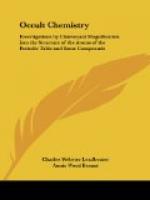Some other observations were made which went to show that as weight-numbers increased, there was a corresponding increase in the number of bodies discerned within the chemical atom; thus, gold showed forty-seven contained bodies; but these observations need repetition and checking. Investigation of a molecule of water revealed the presence of twelve bodies from hydrogen and the characteristic snake of oxygen, the encircling walls of the chemical atoms being broken away. But here again, further observations are necessary to substantiate details. The present paper is only offered as a suggestion of an inviting line of research, promising interesting results of a scientific character; the observations recorded have been repeated several times and are not the work of a single investigator, and they are believed to be correct so far as they go.
THE PLATONIC SOLIDS.
Some of our readers may be glad to have a drawing of the Platonic solids, since they play so large a part in the building up of elements. The regular solids are five, and five only; in each:
(1) The lines are equal.
(2) The angles are equal.
(3) The surfaces are equal.
[Illustration]
It will be seen that the tetrahedron is the fundamental form, the three-sided pyramid on a triangular base, i.e., a solid figure formed from four triangles. Two of these generate the cube and the octahedron; five of these generate the dodecahedron and the icosahedron.
The rhombic dodecahedron is not regular, for though the lines and surfaces are equal, the angles are not.
NOTES.
Mr. C. Jinarajadasa[1] writes:
The asterisk put before metargon in the list of elements should be omitted, for metargon had been discovered by Sir William Ramsey and Mr. Travers at the same time as neon (see Proceedings of the Royal Society, vol. lxiii, p. 411), and therefore before it was observed clairvoyantly. It is not, however, given in the latest list of elements in the Report of November 13, 1907, of the International Atomic Weights Commission, so it would seem as though it were not yet fully recognised.
Neon was discovered in 1898 by Ramsey and Travers, and the weight given to it was 22. This almost corresponds with our weight for meta-neon, 22.33; the latest weight given to neon is 20, and that corresponds within one-tenth to our weight, 19.9. From this it would seem that neon was examined in the later investigations and meta-neon in the earlier.
He says further on a probable fourth Interperiodic Group:
Thinking over the diagrams, it seemed to me likely that a fourth group exists, coming on the paramagnetic side, directly under iron, cobalt, nickel, just one complete swing of the pendulum after rhodium, ruthenium, palladium. This would make four interperiodic groups, and they would come also periodically in the table too.




